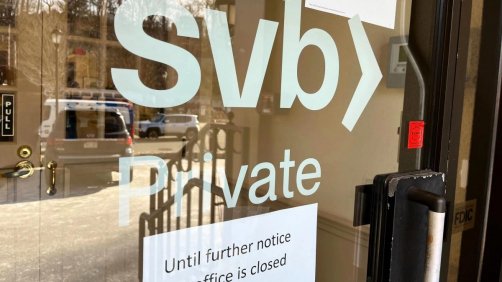Forget the idea that a credit crunch is looming. It’s been here for some time. Look to Silicon Valley.
In the first quarter, venture funding was down 60 percent compared to last year. The number of deals declined for a fifth straight quarter. Private valuations are finally getting marked down. Fund sizes are shrinking. Peter Thiel said it won’t be easy to make money on a $2 billion fund going forward and Y Combinator has shut their late-stage investing business.
Exit activity for venture-backed startups in the fourth quarter plunged more than 90 percent from a year earlier to $5.2 billion, the lowest quarterly total in more than a decade. There hasn’t been a notable venture-backed tech IPO since late 2021, and none appear to be on the horizon.
According to The Information’s Kate Clark, startups find themselves in the unenviable position of entering into “cram down” financings.
If you grew up in the era of easy money, ultralow interest rates and 100 times multiples, it’s possible you’ve never heard about one of these deals, in which investors from previous rounds see their stakes dramatically reduced or wiped out entirely during a company’s desperate plea for cash. These deals, which represent a punishing response to efforts by some startups to survive, are becoming a fixture of dealmaking.
A cram down requires preferred investors to invest pro-rata in future financings. If an investor subject to a pay-to-play provision chooses not to follow on, they can be forced to convert their preferred stock to common stock, losing all their special rights and privileges and being relegated to the back of the cap table with the other common stockholders in an exit.
In a down round a company raises money at a lower valuation than its prior financing round. But it doesn’t come with a massive reverse split or change in terms. A cram down comes with a reverse split, meaning common shares are now worth one tenth, one hundredth and one thousandth of their previous value.
Tonal, a fitness startup, is raising money at a valuation of around $300 million, a decline of 90 percent from its last round. Good Eggs, a startup that delivers $4.99 broccoli bunches, has seen its valuation drop 94 percent, while Benchmark, an earlier investor, lost its stake entirely after choosing not to participate in the $7 million round.
As interest rates have increased over the past year, it is becoming clear that many startups only succeeded because they were able to consistently raise loads of venture capital.
“As cash-burning startups run out of money-raising options, cram downs will become a more normal part of the Silicon Valley discourse,” writes Clark. “Sadly, not all of these companies can be saved, and more importantly, they aren’t all worth saving.”

Source: The Information
Will the credit crunch in Silicon Valley spill over to the rest of the US economy? Our thinking is that it won’t, in line with our view that Silicon Valley is facing a confined downturn, similar to the shale bust of 2015–16.
While job postings are well above pre-pandemic levels, San Francisco and Seattle have 6.5 percent fewer job postings than they did prior to the pandemic, and San Jose has 12 percent fewer. There have been more than three hundred thousand layoffs at tech companies and yet the national labor market is still strong.
We believe Silicon Valley Bank’s (SVB) failure is a continuation of the Silicon Valley bubble unwind. We agree with Michael Barr, vice chair for supervision at the Federal Reserve, who said, “SVB’s failure is a textbook case of mismanagement.” The management team ignored repeated warnings by Fed supervisors who expressed “concern with the bank’s interest rate risk profile.”
What happened to SVB, the self-described “financial partner of the innovation economy,” is unlikely to happen to any other bank. SVB sold bonds at a loss to meet deposit requests. The Fed’s new “Bank Term Funding Program” allows banks to borrow at 100 cents on the dollar for securities trading underwater. Hence, the risk of deposit withdrawals forcing any bank to realize losses on their bond portfolios has gone.
There are nearly $8 trillion of US bank deposits that are uninsured, accounting for more than 40 percent of all deposits. While the FDIC or Treasury cannot provide a blanket guarantee—it requires Congressional action that seems impossible—the actions already taken have prevented further bank runs. Deposits at small banks rose $32 billion in the final two weeks of March. This is a huge improvement over the $196 billion deposit flight in the week ending March 15.
What are the odds that banks retrench? The economy runs on credit. Should they pullback on loans, domino effects on hiring and spending would raise the possibility of a recession.
In the months before the recent banking turmoil, lenders were already tightening their standards and yet the economy has remained robust, with solid growth and a booming job market. In the February NFIB small-business economic trends survey, just 3 percent of small-business owners said their borrowing needs weren’t satisfied. That figure topped 11 percent during the Great Recession.
A quarterly survey of loan officers by the Fed shows that a net 45 percent reported tighter standards for loans to businesses in the first quarter. Excluding the onset of the pandemic, that’s the highest share to say so since 2009. Even so, we don’t anticipate an economy-wide credit crunch.

Source: JP Morgan
At the end of the day, in this crisis, banks don’t have bad assets. They are not busy rebuilding their balance sheets. There’s no concern about credit risk. Delinquency rates across all categories are historically low. The consumer is healthy, and the economy has substantial momentum.
While total US bank deposits have fallen by around $700 billion since the Fed began raising interest rates last year, at $17.5 trillion they are still $4 trillion above pre-pandemic levels. That is in part due to the fiscal and monetary policy response to the pandemic. The Treasury sent stimulus and other relief payments directly to household bank accounts.
This is why banks have not raised deposit rates as money flowed into money-market funds. There is no shortage of deposits in the banking system. The ratio of bank loans to deposits is hovering close to a 50-year low of around 60 percent. While deposit rates may now be adjusted higher, there is no fight for deposits nor a funding pinch for banks that could weigh on the provision of loans to consumers and businesses. They have plenty of liquidity.
Looking at past cycles, it is not until the demand side of the economy seriously downshifts, and the Fed is cutting rates, and the yield curve steepens, that credit growth grinds to a halt. Curve inversion by itself is not a problem for loan growth.
The yield curve inverted from 1988 until the fall of 1990 as tight monetary conditions and the Savings and Loan crisis led bond markets to price an impending slowdown. Yet it wasn’t until the summer of 1990 when Iraq invaded Kuwait and oil prices doubled that the US economy dove into recession. And it wasn’t until 1992, a full year after the recession ended that bank lending contracted.
A similar thing occurred in 2001. The Fed raised rates from 1994 until the summer of 2000, and from January to December of that year the yield curve inverted. Lending decelerated throughout 2001, but it wasn’t until after the September 11 terror attacks that it plummeted. As in the early nineties, credit contracted a year after the recession ended and following eighteen months of yield curve steepening.
Even during the subprime credit crisis, bank lending continued to flow smoothly despite the yield curve inverting from January 2006 until May 2007. Credit growth continued in the face of Lehman’s bankruptcy. It was not until the Fed was cutting rates aggressively and began quantitative easing as the curve had steepened that credit contracted in 2009.
In our current cycle, the yield curve has been inverted since June. Over this period, total commercial bank loans increased by over $600 billion. Simply put, there is little evidence that, in the absence of a negative demand shock, yield curve inversion or tightening lending standards impair credit expansion.
Venture-backed firms may have to deal with higher borrowing costs, stricter terms, or even possibly closed doors as a result of SVB’s failure. But just because the knives are out in Silicon Valley does not mean that consumers and businesses across America won’t have access to credit. The economy will be just fine.







